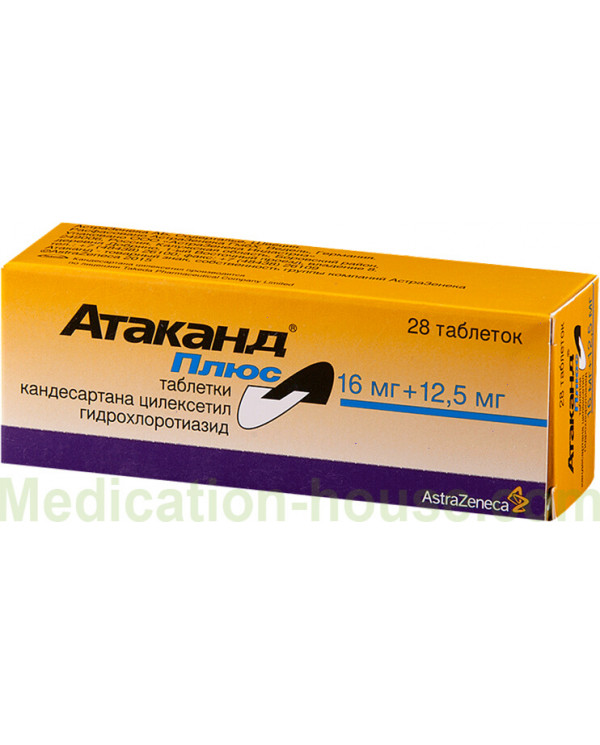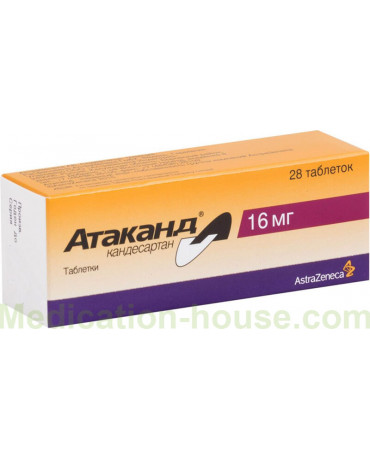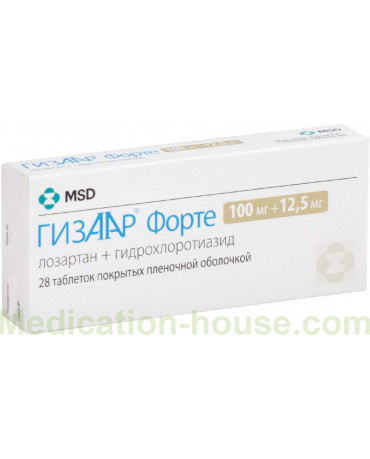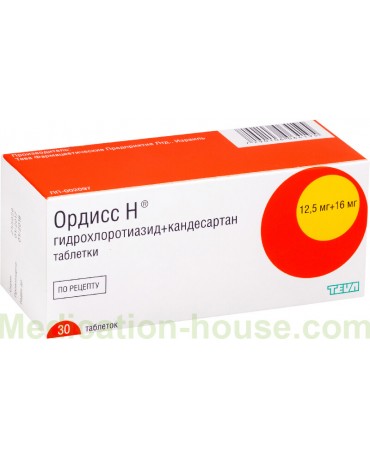Instruction for Atacand Plus
Reed more and buy Atacand Plus here
Atacand Plus is a combined antihypertensive agent.
Release form and composition
Dosage form - tablets: biconvex, oval, pink, with a notch on both sides and A / CS engraving on one side (14 pcs in blisters, 2 blisters in a cardboard box and instructions for use of Atacand Plus).
Composition of 1 tablet:
active substances: candesartan cilexetil - 16 mg, hydrochlorothiazide - 12.5 mg;
auxiliary components: macrogol, magnesium stearate, lactose monohydrate, hyprolose, corn starch, calcium carmellose, dyes of iron oxide red and iron oxide yellow.
Pharmacodynamics
Candesartan cilexetil
Angiotensin II (hypertensin) is one of the most important components of the renin-angiotensin-aldosterone system (RAAS). This hormone plays an important role in the pathogenesis of arterial hypertension, heart failure and other diseases of the cardiovascular system. Its main physiological effects: regulation of the water-electrolyte state, stimulation of cell growth and aldosterone production, vasoconstriction. They are mediated by the interaction of angiotensin II with type 1 angiotensin receptors (AT1 receptors).
Candesartan is a selective angiotensin II AT1 receptor antagonist. The substance does not lead to the accumulation of bradykinin or substance P (a neuropeptide from the tachykinin family), and also does not inhibit the angiotensin-converting enzyme (ACE), which converts angiotensin I to angiotensin II, which destroys bradykinin. Due to the blocking of the AT1 receptors of angiotensin II, a dose-dependent increase in the level of renin, angiotensin I and angiotensin II occurs, as well as a decrease in the plasma concentration of aldosterone.
Compared with the use of ACE inhibitors, candesartan is less likely to cause the development of cough. The substance does not bind to receptors of other hormones, does not block ion channels involved in the regulation of the function of the cardiovascular system.
In randomized clinical trials (SCOPE - study of cognitive functions and prognosis in elderly patients), the effect of candesartan on morbidity and mortality in mild to moderate arterial hypertension was studied. They involved 4937 patients aged 70–89 years (over 80 years old - 21% of patients). Patients took candesartan (in daily doses from 8 to 16 mg in 1 dose for an average of 3.7 years) or placebo, if necessary, simultaneously with other antihypertensive drugs. In the candesartan group, a decrease in blood pressure (BP) was observed from 166/90 to 145/80 mm Hg. Art., in the control group - from 167/90 to 149/82 mm Hg. Art. There were no significant differences between the two groups of patients in the incidence of cardiovascular complications (the incidence of myocardial infarction and stroke that did not lead to death, as well as in the incidence of deaths due to cardiovascular diseases).
Hydrochlorothiazide
Hydrochlorothiazide is a thiazide-like diuretic that inhibits active sodium reabsorption mainly in the distal renal tubules, and also enhances the excretion of water, chlorine and sodium ions. In this case, calcium begins to be reabsorbed in greater quantities than before, and the intensity of excretion of magnesium and potassium by the kidneys is dose-dependent.
Hydrochlorothiazide reduces the volume of extracellular fluid and blood plasma, slows down the rate of blood transport by the heart and lowers blood pressure. With prolonged use, the antihypertensive effect develops due to the expansion of arterioles. Long-term therapy reduces the risk of cardiovascular disease and mortality.
Candesartan + hydrochlorothiazide combination
Used in combination, candesartan and hydrochlorothiazide have an additive hypotensive effect.
Atacand Plus promotes an effective and long-term decrease in blood pressure without increasing the heart rate (HR). Taking the first dose is not accompanied by the development of orthostatic arterial hypotension, the cancellation of therapy does not contribute to an increase in arterial hypertension.
The antihypertensive effect after a single dose of Atacand Plus develops within 2 hours. In the case of using the drug once a day, blood pressure decreases gently and effectively within 24 hours, while the maximum and average effects differ slightly. A stable decrease in blood pressure as a result of prolonged therapy is observed after about 4 weeks and persists with continued administration of the drug.
In clinical studies, it was found that adverse reactions (especially cough) due to the use of Atacand Plus occur less often than in patients using ACE inhibitors in combination with hypothiazide.
The effectiveness of the drug does not depend on the patient's age and gender.
There is no data on the use of Atacand Plus in renal failure, nephropathy, acute heart failure, reduced left ventricular function, as well as after myocardial infarction.
Pharmacokinetics
Candesartan cilexetil
Candesartan cilexetil is a prodrug: after absorption from the gastrointestinal tract by ether hydrolysis, it turns into candesartan, an active substance that strongly binds to AT1 receptors and slowly disintegrates, does not have agonistic properties.
With oral administration of candesartan cilexetil in the form of a solution, the absolute bioavailability of candesartan is approximately 40%. The relative bioavailability of the drug in tablets compared to oral solution is ~ 34%. Thus, the calculated absolute bioavailability of the candesartan tablets is 14%. No significant changes in the AUC (areas under the concentration-time curve) were observed with food intake, ie, food does not significantly affect the bioavailability of the drug.
The maximum concentration (Cmax) in the blood serum is observed 3-4 hours after taking the drug in tablet form. Increasing the dose in the therapeutic range leads to a linear increase in the concentration of candesartan.
Candesartan is characterized by high binding to plasma proteins - more than 99%. Plasma volume of distribution (Vd) - 0.1 l / kg.
Total clearance is about 0.37 ml / min / kg, renal clearance is about 0.19 ml / min / kg. Renal excretion of the drug occurs by active tubular secretion and glomerular filtration.
The half-life (T1 / 2) is ~ 9 hours.
Candesartan is metabolized to a small extent by the liver, excreted mainly unchanged in the urine and bile. Does not accumulate in the body.
After oral administration of radioactively labeled candesartan cilexetil, about 26% of the dose was excreted in the urine in the form of candesartan, 7% in the form of an inactive metabolite. In this case, 56% of the dose was found in the feces in the form of candesartan, 10% in the form of an inactive metabolite.
Pharmacokinetic parameters of the drug do not depend on the gender of the patient.
In elderly patients over 65 years of age, the Cmax and AUC of candesartan increase by 50 and 80%, respectively. However, the antihypertensive effect and the incidence of adverse reactions do not differ from those in younger patients.
With mild and moderate impairment of renal function, the Cmax and AUC of the drug increase by 50 and 70%, respectively, but T1 / 2 does not change (it is the same as in patients with normal renal function).
With severe functional disorders of the kidneys and / or hemodialysis, the Cmax and AUC of candesartan increase by 50 and 100%, respectively, and T1 / 2 - 2 times.
In patients with mild to moderate liver functional impairment, an increase in the AUC of the drug by 23% was noted.
Hydrochlorothiazide
After oral administration, it is rapidly absorbed from the gastrointestinal tract. Food increases absorption by about 15%.
Bioavailability is approximately 70%. With heart failure and severe edema, this indicator can be reduced.
It binds to plasma proteins by about 60%. The apparent Vd is ~ 0.8 l / kg.
Hydrochlorothiazide does not undergo biotransformation and is excreted from the body almost completely unchanged by glomerular filtration and active tubular secretion in the proximal nephron.
T1 / 2 is approximately 8 hours, while taking candesartan does not change, but increases in patients with renal failure.
Approximately 70% of the dose is excreted in the urine within 48 hours.
Hydrochlorothiazide does not accumulate in the body, including when used in combination with other drugs.
Indications for use
Atacand Plus is used in patients with arterial hypertension, which requires combination therapy.
Contraindications
Absolute:
anuria;
renal dysfunction [creatinine clearance (CC) <30 ml / min / 1.73 m2)];
refractory hypokalemia and hypercalcemia;
liver dysfunction and / or cholestasis;
gout;
age up to 18 years;
period of pregnancy and lactation;
hypersensitivity to any component of the drug or sulfonamide derivatives.
Relative (Atacand Plus tablets are used with caution, after assessing the benefits and risks):
bilateral stenosis of the renal arteries, stenosis of the artery of a single kidney;
renal failure;
conditions after kidney transplantation;
hyponatremia;
severe chronic heart failure;
hypertrophic obstructive cardiomyopathy;
coronary heart disease;
hemodynamically significant stenosis of the aortic / mitral valve;
reduced volume of circulating blood;
cerebrovascular diseases;
primary hyperaldosteronism;
cirrhosis of the liver;
lactose intolerance, malabsorption of lactose and galactose;
diabetes.
Atacand Plus, instructions for use: method and dosage
Atacand Plus tablets are taken orally, regardless of the meal time.
Adults are usually prescribed 1 tablet 1 time per day.
Before transferring a patient to Atacand Plus, titration of the dose of candesartan is recommended (through monotherapy with Atacand).
Atacand Plus can be used to transfer patients in whom monotherapy with Atacand does not allow achieving the required reduction in blood pressure.
When choosing a dose, it should be borne in mind that it usually takes 4 weeks to achieve the main hypotensive effect.
For functional disorders of the kidneys, it is more preferable to use loop diuretics than thiazide ones. Before starting treatment with the drug for mild and moderate impairment of renal function (CC> 30 ml / min / 1.73 m2), including patients on hemodialysis, careful selection of the dose of candesartan is recommended, starting with 4 mg. In severe renal failure (CC <30 ml / min / 1.73 m2) Atacand Plus is contraindicated.
In the case of an existing risk of arterial hypotension (for example, with a reduced volume of circulating blood), titration of the dose of candesartan is recommended, starting with 4 mg.
Side effects
Undesirable effects recorded in clinical trials were moderate and transient. The incidence rates were comparable to those in the placebo group. Discontinuation of therapy due to severe adverse reactions was required in 3.3% of patients, which is approximately comparable to the placebo group - 2.7%.
In a pooled analysis of data from clinical trials, the following phenomena were noted caused by the use of a combination of candesartan + hydrochlorothiazide: weakness and dizziness. In some patients, there was a slight increase in aspartate aminotransferase and hemoglobin concentration in the blood plasma, an increase in urea and creatinine, hyponatremia and hyperkalemia.
Candesartan cilexetil
The following side effects reported in a post-marketing study were very rare in patients receiving candesartan cilexetil (<1/10 000):
from the digestive system: nausea, increased activity of liver enzymes, liver dysfunction, hepatitis;
from the side of metabolism: hyponatremia, hyperkalemia;
from the central nervous system: dizziness, headache;
from the urinary system: impaired renal function, including renal failure in predisposed patients;
from the hematopoietic system: neutropenia, leukopenia, agranulocytosis;
from the musculoskeletal system: back pain, myalgia, arthralgia;
from the immune system: itching, urticaria, skin rashes, angioedema;
others: increased uric acid and blood glucose levels.
Hydrochlorothiazide
When using hydrochlorothiazide as a monopreparation in doses of 25 mg or more, the following side effects were reported (the frequency of their development is classified as follows: often -> 1/100, sometimes - from> 1/1000 to <1/100, rarely - <1/1000 ):
on the part of the cardiovascular system: sometimes - orthostatic arterial hypotension; rarely - arrhythmia, cutaneous vasculitis, necrotizing vasculitis;
from the digestive system: sometimes - diarrhea / constipation, loss of appetite; rarely - intrahepatic cholestatic jaundice, pancreatitis;
from the side of metabolism: often - hypertriglyceridemia, hypokalemia, hyponatremia, hyperuricemia, hypercholesterolemia, hyperglycemia; rarely - an increase in creatinine levels;
from the respiratory system: rarely - shortness of breath (pneumonia, pulmonary edema);
from the central and peripheral nervous system: often - headache, light dizziness; rarely - anxiety, sleep disturbance, paresthesia, depression;
from the urinary system: often - glucosuria; rarely - functional impairment of the kidneys, interstitial nephritis;
on the part of the hematopoietic system: rarely - anemia (including aplastic), agranulocytosis, neutropenia, thrombocytopenia, leukopenia, bone marrow depression;
from the musculoskeletal system: rarely - myalgia;
on the part of the sense organs: rarely - transient blurred images;
from the immune system: sometimes - skin rash, photosensitization, urticaria; rarely - reactions similar to cutaneous erythematosis, recurrence of cutaneous erythematosis, epidermal necrosis, anaphylactic reactions;
others: often - weakness; rarely - a feeling of heat.
Overdose
Considering the pharmacological properties of Atacand Plus, it is assumed that the main symptoms of an overdose may be dizziness and a marked decrease in blood pressure. There are isolated cases of overdose (up to 672 mg of candesartan), which ended in the recovery of patients without serious complications. An overdose of hydrochlorothiazide can manifest as acute loss of fluid and electrolytes. A decrease in blood pressure, dry mouth, muscle cramps, loss of consciousness, dizziness, tachycardia, ventricular arrhythmia are also possible.
With a pronounced decrease in blood pressure, the patient should be laid horizontally with raised legs. Treatment is symptomatic under the control of the patient's condition. If necessary, increase the volume of circulating blood, for example, by intravenous infusion of isotonic sodium chloride solution. If necessary, the doctor will prescribe sympathomimetic agents. Hemodialysis is ineffective.
Special instructions
Patients with renal impairment should be treated with regular monitoring of potassium, uric acid and creatinine levels.
Many drugs that affect the RAAS (eg, ACE inhibitors), in patients with bilateral renal artery stenosis or stenosis of a single kidney artery, cause an increase in serum creatinine and blood urea. Candesartan may have a similar effect.
In the case of a deficiency of intravascular volume and / or sodium, there is a high risk of developing symptomatic arterial hypotension. It is recommended to eliminate these violations before the appointment of Atacand Plus.
With surgical interventions and the use of anesthesia in patients receiving angiotensin II antagonists, arterial hypotension may develop due to blockade of the renin-angiotensin system. There are rare cases of severe hypotension requiring appropriate treatment, including the administration of fluids and / or vasoconstrictors.
With extreme caution, hydrochlorothiazide should be used for progressive diseases and functional disorders of the liver, since even minor fluctuations in the electrolyte composition and volume of fluid can lead to the development of hepatic coma.
Patients with primary hyperaldosteronism are usually resistant to the effects of drugs affecting the RAAS, therefore, the use of Atacand Plus is inappropriate.
Hydrochlorothiazide can reduce the excretion of calcium ions in the urine, increase the concentration of calcium ions in the blood plasma, and cause disturbances in the water-salt balance (hyponatremia, hypokalemia, hypercalcemia, hypomagnesemia, hypochloremic alkalosis).
It should be borne in mind that hypercalcemia developed against the background of antihypertensive therapy (under the influence of hydrochlorothiazide) may indicate the presence of latent hyperthyroidism. Atacand Plus should be canceled before examining the parathyroid gland.
Hydrochlorothiazide dose-dependently increases the excretion of potassium, which may lead to the development of hypokalemia. This effect is lower when combined with candesartan cilexetil. The risk of hypokalemia is increased in the following cases: increased diuresis, liver cirrhosis, renal failure, heart failure, fluid intake with low salt content, the use of glucocorticosteroids or adrenocorticotropic hormone. Also, hydrochlorothiazide increases the excretion of magnesium, which is fraught with hypomagnesemia.
During the period of therapy, monitoring of electrolytes in blood plasma is required.
The simultaneous use of Atacand Plus and drugs that increase the excretion of potassium can be compensated for by taking food supplements containing potassium or other drugs that can increase the plasma level of potassium.
Thiazide-like diuretics are capable of changing the concentration of glucose in the blood, up to the development of latent diabetes mellitus. With diabetes mellitus, it may be necessary to adjust the dosing regimen of hypoglycemic agents / insulin.
Hydrochlorothiazide may cause an increase in plasma triglyceride and cholesterol levels. However, when using the dose of 12.5 mg contained in Atacand Plus, these effects are minimal or absent at all.
Hydrochlorothiazide increases the plasma level of uric acid, and in predisposed patients it can contribute to the onset of gout.
There are known cases of symptoms or exacerbation of congestive seborrhea in patients receiving thiazide-like diuretics.
The risk of hypersensitivity reactions to hydrochlorothiazide is increased in patients with a history of allergic reactions and in patients with bronchial asthma. However, the likelihood of allergies in other patients is also possible.
Patients whose renal function and vascular tone depend mainly on the activity of the RAAS (for example, in severe chronic insufficiency and kidney disease, including renal artery stenosis), are especially sensitive to drugs acting on the RAAS. Taking these drugs can cause severe arterial hypotension, azotemia and oliguria, less often acute renal failure. The risk of developing the described effects is not excluded with the use of angiotensin II receptor antagonists (candesartan). In patients with cerebrovascular diseases of ischemic genesis and ischemic cardiopathy, a sharp decrease in blood pressure while taking any antihypertensive agent can lead to the development of stroke or myocardial infarction.
Influence on the ability to drive vehicles and complex mechanisms
The effect of the combination candesartan + hydrochlorothiazide on the cognitive and psychomotor functions of the patient has not been studied. However, the pharmacodynamic properties of Atacand Plus indicate that there is no negative effect. However, given the likelihood of dizziness and increased fatigue, during the period of therapy, it is recommended to be careful when performing potentially hazardous activities.
Application during pregnancy and lactation
In animal studies, it has been established that the use of candesartan is fraught with damage to the kidneys of the fetus in the embryonic and neonatal periods.
Hydrochlorothiazide can reduce blood plasma volume and uteroplacental blood flow, and cause thrombocytopenia in a newborn.
Clinical experience with the use of Atacand Plus during pregnancy is not enough to assess its possible negative impact on the development of the fetus in the first trimester. At a later date, taking the drug is associated with high risks, since in the second trimester, the kidney blood supply system begins to form in the embryo, which depends on the development of the RAAS. Thus, taking drugs in the II – III trimesters of pregnancy that have a direct effect on the RAAS (including candesartan cilexetil) can cause fetal development disorders or have a negative effect on the newborn: intrauterine growth retardation, hypoplasia of the skull bones, anuria and / or oliguria, impaired renal function, arterial hypotension, oligohydramnios. Some of them can be fatal. There are also known cases of limb contracture, facial anomalies and lung hypoplasia.
In connection with the above, Atacand Plus is contraindicated for use during pregnancy. In case of pregnancy during the period of therapy, the drug should be canceled.
In animal studies, it was found that candesartan and hydrochlorothiazide penetrate into the milk of lactating rats. Assuming a possible negative effect on infants, Atacand Plus should not be used during lactation, or breastfeeding should be stopped.
Pediatric use
There is no data on the efficacy and safety of the drug in pediatrics, therefore, Atacand Plus is not used to treat children and adolescents under 18 years of age.
With impaired renal function
contraindicated: anuria, impaired renal function with CC <30 ml / min / 1.73 m2;
caution is required: renal failure, bilateral renal artery stenosis, stenosis of an artery of a single kidney, conditions after kidney transplantation.
For violations of liver function
contraindicated: impaired liver function, cholestasis;
caution is required: cirrhosis of the liver.
Use in the elderly
In old age, there is no need to adjust the dose of Atacand Plus.
Drug interactions
In the course of pharmacokinetic studies, the mutual influence of Atacand Plus with the following drugs was studied: hydrochlorothiazide, digoxin, warfarin, glibenclamide, enalapril, nifedipine, oral contraceptives (ethinylestradiol / levonorgestrel). No clinically significant interactions have been identified.
Studies of candesartan have not shown any effect on CYP2C9 and CYP3A4. The effect on other isozymes of the cytochrome P450 system has not been studied.
With the simultaneous use of other antihypertensive drugs with Atacand Plus, the antihypertensive effect is potentiated.
Experience with other drugs acting on the RAAS shows that the simultaneous administration of potassium-sparing diuretics, potassium preparations, potassium-containing salt substitutes, as well as agents that increase serum potassium levels (for example, heparin), can cause hyperkalemia.
ACE inhibitors cause a reversible increase in serum lithium levels and the development of toxic reactions. This effect can also be observed with the use of angiotensin II receptor antagonists, therefore it is recommended to control the concentration of lithium in the blood in case of their simultaneous use.
With the concomitant use of glucocorticosteroids or adrenocorticotropic hormone, the risk of hypokalemia increases.
General anesthetics, alcohol and barbiturates can increase the incidence of orthostatic arterial hypotension.
The loss of potassium caused by hydrochlorothiazide can be enhanced by other drugs with a similar effect, including diuretics, salicylic acid derivatives, laxatives, penicillin G sodium, carbenoxolone, amphotericin.
Non-steroidal anti-inflammatory drugs weaken the hypotensive, diuretic and natriuretic effects of hydrochlorothiazide. Its absorption is reduced by colestipol and colestyramine. Anticholinergics (eg atropine, biperidine) can increase its bioavailability.
With the simultaneous use of other drugs, it should be borne in mind that hydrochlorothiazide can:
enhance the effect of non-depolarizing muscle relaxants (for example, tubocurarine);
increase the hyperglycemic effect of diazoxide and beta-blockers;
increase the risk of adverse effects of amantadine;
reduce the effect of vasoconstrictor amines (eg epinephrine);
slow down the excretion of cytostatic agents (for example, methotrexate, cyclophosphamide) and enhance their myelodepressant effect;
increase the level of calcium in the blood (if necessary, the simultaneous use of vitamin D or calcium-containing food supplements, it is necessary to control the plasma level of calcium, if necessary, adjust the dose);
increase the risk of developing acute renal failure, especially in combination with large doses of iodized filler;
cause hypokalemia and hypomagnesemia, which predispose to the possible cardiotoxic effect of antiarrhythmic drugs and digitalis glycoside (monitoring of potassium concentration in the blood is necessary);
reduce glucose tolerance (dose adjustment of hypoglycemic drugs / insulin may be required).
No significant interaction of hydrochlorothiazide with food has been identified.
Terms and conditions of storage
Store at a temperature not exceeding 30 ° C out of reach of children.
The shelf life is 3 years.
Reviews about Atacand Plus
In positive reviews about Atacand Plus, patients confirm the high efficacy of the drug and note that with its help they managed to stabilize blood pressure and maintain it at the required level for many years.
The negative messages describe side effects, including serious ones, due to which the treatment had to be interrupted.
All patients call the cost of Atacand Plus high, some of them believe that the price is too high and is not justified.
Terms of sell
You don't need a prescription from a doctor to buy Atacand Plus.




